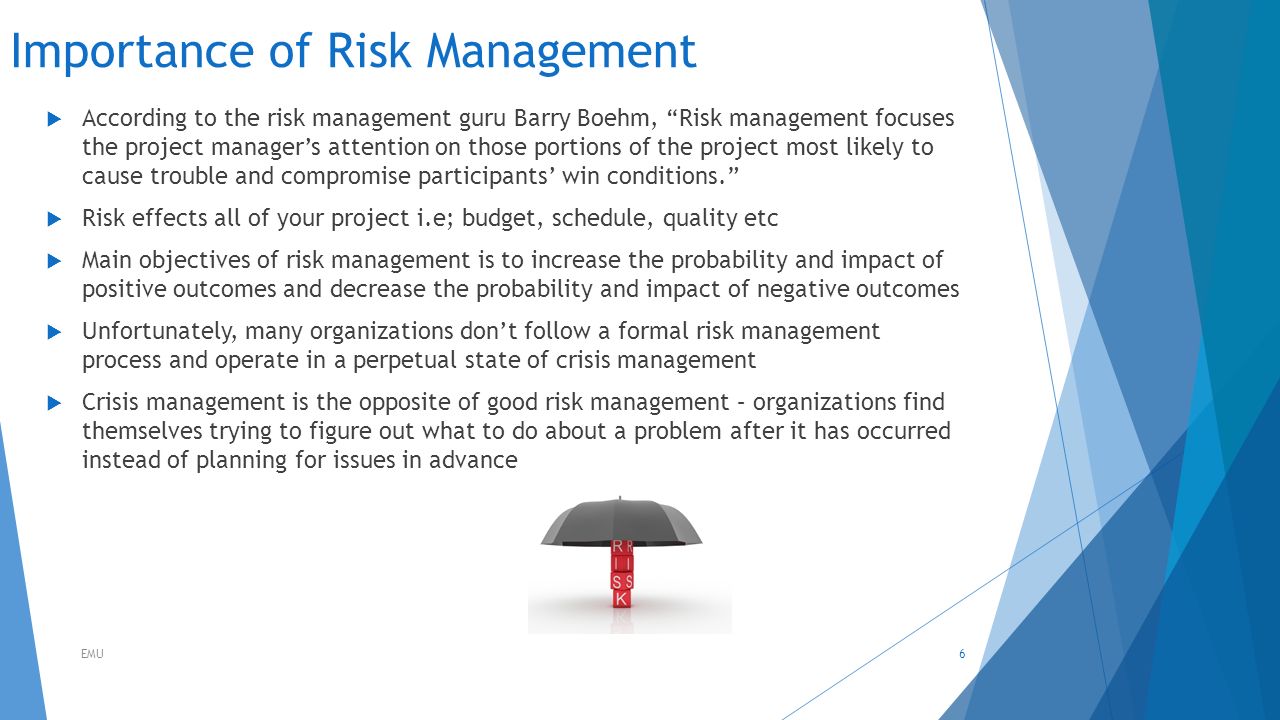Exploring the Long-Term Benefits and Importance of Risk Management for New Businesses
Exploring the Long-Term Benefits and Importance of Risk Management for New Businesses
Blog Article
Exploring the Value of Risk Management for Effective Decision-Making Methods
In the elaborate world of business, Risk Management arises as a crucial factor in the decision-making procedure. The capability to determine potential threats and possibilities, and strategize appropriately, can spell the distinction in between success and failure.
Comprehending the Principle of Risk Management
Risk Management, a crucial part in decision-making, is commonly misunderstood or oversimplified. Risk Management entails disciplined and organized methods, using information and insightful assessments. From monetary uncertainties, legal obligations, calculated Management mistakes, to mishaps and all-natural calamities, it deals with numerous dangers - importance of risk management.
The Duty of Risk Management in Decision-Making Processes
In the realm of strategic preparation and service operations, Risk Management plays an essential function in decision-making processes. Risk Management hence comes to be an essential tool in decision-making, assisting leaders to make enlightened options based on a comprehensive understanding of the dangers included. Risk Management offers as a crucial element in the decision-making processes of any kind of company.

How Risk Management Boosts Strategic Planning
In the context of tactical planning, Risk Management plays a critical duty. Launching with the recognition of possible dangers, it additionally encompasses the execution of Risk mitigation actions. The role of Risk Management is not fixed however vibrant, as it requires consistent monitoring and adjusting of strategies.
Recognizing Prospective Dangers

Implementing Risk Mitigation
Having actually developed the value of recognizing prospective risks, the next action is to check out Risk reduction. This procedure entails establishing and implementing strategies to manage recognized risks properly. It is an important aspect of tactical preparation as it enhances decision-making by reducing possible unfavorable outcomes. Risk mitigation strategies can vary from Risk evasion, Risk transfer, to risk reduction. Each approach ought to be customized to the particular Risk, considering its potential impact and the company's Risk tolerance. Effective Risk reduction needs a deep understanding of the Risk landscape and the possible influence of each Risk. This understanding allows organizations to focus on dangers and allot resources efficiently, ensuring that one of the most significant risks are resolved initially.
Monitoring and Readjusting Strategies
Though Risk mitigation is a vital action in calculated preparation, continual monitoring and modification of these techniques is similarly crucial. It additionally offers a chance to examine the success of the Risk Management measures, enabling adjustments to be made where necessary, more improving critical preparation. Surveillance and readjusting Risk Management strategies is a vital element for enhancing an organization's resilience and calculated planning.
Case Studies: Effective Risk Management and Decision-Making
In the globe of organization and money, successful Risk Management and decision-making usually serve as the columns of prosperous business. These cases highlight the value of sharp Risk Management in decision-making procedures. These instances emphasize the essential role of Risk Management in tactical decision-making.
Devices and Strategies for Reliable Risk Management
These tools, such as Risk registers and warm maps, help in recognizing and analyzing potential risks. Risk reaction strategies, an essential element of Risk Management, include accepting, preventing, moving, or mitigating risks. With these strategies and devices, decision-makers can navigate the complicated landscape of Risk Management, thus assisting in informed and efficient decision-making.
Future Patterns in Risk Management and Decision-Making Approaches
As we discover the substantial landscape of Risk Management, it becomes apparent that the techniques and tools used today will certainly proceed to advance. Future patterns direct towards an enhanced site reliance on technology, with expert system and equipment discovering playing considerable functions. These technologies will enable companies to anticipate prospective dangers with higher accuracy and make more enlightened choices. Additionally, there will be a growing emphasis on durability, not just in taking care of dangers yet likewise in getting better from unfavorable scenarios. The concept of Risk culture, where every member of an organization is conscious and entailed in Risk Management, will certainly gain a lot more prestige. These trends advertise an even more positive and site comprehensive method in the direction of Risk Management and decision-making.
Conclusion

Risk Management thus comes to be an important tool in decision-making, helping leaders to make enlightened selections based on a thorough understanding of the threats included. Risk reduction methods can range from Risk evasion, Risk transfer, to take the chance of decrease (importance of risk management). Effective Risk mitigation requires a deep understanding of the Risk landscape and the potential influence of each Risk. Risk action techniques, a key component of Risk Management, entail accepting, staying clear of, transferring, or mitigating threats. The idea of Risk society, where every member of a check here company is conscious and entailed in Risk Management, will gain extra importance
Report this page